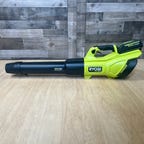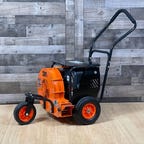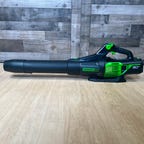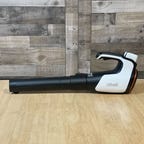Best Leaf Blowers for 2024
We've tested the best leaf blowers out there, considering power, noise, weight and value.
Our Picks


Which is the best leaf blower?
If you're shopping for a new leaf blower, there are a ton of options out there. As such, it can be overwhelming to find the best one for you. Our top pick is the Greenworks Pro 80-volt cordless leaf blower, mainly thanks to its energy-efficient design and best-in-class air power. Other factors, however, such as noise level, relative value and weight are also important. We've spent weeks testing and evaluating the things in our lab to make some informed recommendations.
If you've spent any of your life in the suburban or more rural areas of the US, it's tough to remember a time when leaf blowers weren't a thing. Even if your family didn't own one, it's likely that your friend, neighbor or the guy down the street probably did. Although larger walk-behind versions were available as early as the 1950s, the more traditional backpack and handheld types didn't appear until the 1970s, according to the October 1977 issue of Popular Science.
But the landscape is changing. All those leaf blowers we remember from years past were gas-powered. Today some cities and states have outlawed gas-powered leaf blowers outright, and even more areas restrict the days and times you can use any type of leaf blower. Check out the laws and regulations for leaf blowers in the US.
Even today, leaf blowers are one of the quickest and most effective ways of moving leaves and other bits of debris around on your property. They're much better than the other traditional methods such as raking and sweeping. We've tested several of the standard electric models available on the market today, considering things like how much power their airflow actually offers, as well as other common concerns like battery life and how loud each unit gets. Let's take a look at the best of the best.
Best leaf blowers for 2024
This 80-volt Greenworks model proved to be not only our best overall leaf blower, but also our most powerful leaf blower. During our propulsion tests, where we use each leaf blower to power a custom-built air cannon and see how far they'll shoot a weight, Greenworks was the clear winner in the "turbo mode" category, with an average distance of 34 feet and 11 inches. Even in standard mode, its average distance of 26 feet and 8 inches would have placed third overall in the turbo category. No other leaf blower we tested moved air with more power.
Additionally, Greenworks seems to have the most efficient power relay in terms of being able to translate its voltage system and included battery into raw power. Our only real criticism on the power front is that the Greenworks leaf blower comes with the smallest battery capacity of all units we've tested -- a lowly 2.5 amp-hours. Still, that size battery is probably good enough for most medium and lighter jobs -- and the fact that the output is highest of all the units tested means you'll likely spend less time on the same job than you would with other, less powerful leaf blowers.
This is one of the heavier models we tested, at about 10 pounds, which can become tiring after you've held it for some time. But, as with most units, you do have a strap option and there are already metal hooks in place on the unit for that exact purpose. At $250, the cost is relatively average among the models we tested, so I would consider this a great buy. And if you also own any other Greenworks 80V battery-platform tools, the leaf blower's battery can power those, too.
Quietest leaf blower
Ryobi 40V Whisper Series Cordless Leaf Blower
This Ryobi unit had a fair showing overall. Only one other leaf blower we tested cost less, and it outperformed a few models that cost more in our propulsion tests. That left it as a reasonable middle-of-the-pack performer -- but if you're looking for something quiet, it might be the exact leaf blower you're looking for. While all of the other leaf blowers we tested hit decibel levels nearing 100dB, the Ryobi blower was the quietest, ringing in at a more moderate 81.5dB.
Like the Greenworks model, the Ryobi leaf blower's battery is compatible with other Ryobi tools, making some nice added value for brand loyalists. With a massive tool platform behind it, and at a time when restrictions on non-electric leaf blowers are on the rise, this is an easy pick.
Best cordless leaf blower on a budget
Litheli 20V model U20BR00-0A220
This Litheli unit is the cheapest on our list closely accompanied by Craftsman and Seyvum, and it's one of three models we tested that runs off 20 volts or less. Even so, it managed to punch above its weight in our tests, earning third and fourth places, respectively, in our normal and turbo mode propulsion tests (excluding the DK2 model).
Another key point: It's also one of the lighter leaf blowers we tested. That makes it a great choice for anyone who might find a heavier leaf blower exhausting to carry.
All told, the above-average performance, the lightweight design, and the appealingly low price point make the Litheli leaf blower our best budget pick for the leaf blower category.
Best leaf blower for professional use
DK2 Elite Energy 57.6V walk behind leaf blower
To be fair, this unit is currently the only professional-level leaf blower we've tested hands-on. That said, we're impressed with its overall performance and platform, so it's worth mentioning here.
As far as pros and cons, let's get the big con out of the way: price. At just under $1,800, you probably won't consider picking this up to handle your 0.2 acre lot's worth of leaves each fall. But, if you use a blower often, or have a large coverage area, or do this work professionally, it's worth a look.
There's really only one power level: on. At that level, this unit scores higher than our leading handheld does on turbo. The difference isn't actually as much as you might expect, but that Greenworks model on turbo is already outperforming all the other units by at least 25%, so it's an impressive benchmark to beat.
Add the fact that this thing is on wheels, and its 57.6-volt battery has at least four times the capacity of any of the handhelds, and you really have something to work with. The DK2 platform might also be worth a look for the other tools that work with the same battery.
How we test leaf blowers
We test lots of things here at the Louisville-based CNET Test Lab. Some tests are easy, some are more difficult. Some take a few minutes and some take days. Creating test protocols for new product categories is always exciting, but let me tell you that anytime the phrase "air cannon" comes up in our proposed test methodologies, there's a bit of extra electricity in the air.
Some cannon fodder courtesy of Gianmarco and Bryan from the CNET Labs team.
We'll get to the air cannon results in a bit, but we start our tests by actually using the leaf blowers as intended. We hold them, we push the buttons, we blow stuff around -- you know, leaf blower-y stuff. As we go, we make sure to evaluate the balance and ergonomics of the overall design, including attachments. A product that performs well but is difficult to use -- or one that's literally painful to your person -- well, that isn't likely to score well.
Electric leaf blower noise levels
We do love our data, so we make sure to collect and analyze manufacturer specs alongside our own test data. There are two main points of data that we collect for leaf blowers: The first is sound level.
As a contributor to restrictions being placed on outdoor tools across the country, excessive noise can be quite the bother. That's why we run a sound level test for each model, placing it at approximately the distance you might expect to find this type of product operating from your ear. We position it perpendicular to the sound level meter and record the results. You can see those results in the graph above, where it's clear that Ryobi's blower is, by far, the quietest of all the units we tested. Everything else sits in a cluster as they race for loudest leaf blower -- a title currently held by the Enhulk Max Pro Series 58V.
This is where our propulsion cannon comes in. Yes, we could have grabbed some leaves and some loose debris and blown it around our test spaces, and said, "Hey, this thing blows leaves." But we wanted to go one step further and see how the leaf blowers' output translated to raw power.
CNET's air cannon for leaf blower testing.
To do this, we built an air cannon mostly from 3-inch PVC. Amenities included are an air gate, so we can ramp up each unit and release all the air into the cannon instantly, and a restriction plate, to keep the projectile from entering the core of the apparatus. There's also a base for balancing and a 5-foot barrel for launching the projectile.
The projectile itself is a round plastic tube (similar to those pneumatic-driven tube containers at bank drive-throughs) containing a sand mixture and, in total, weighs 210 grams.
Here's Eric from our lab demonstrating the air cannon in action. Each colored line represents the longest average distance achieved by each model -- of all of them, the Greenworks Pro leaf blower shot our weight the farthest. All of those high scores were achieved in the respective blower's turbo mode, except for the DeWalt leaf blower, which only has a single setting.
We load the projectile into the cannon, secure the leaf blower nozzle into the input port, ramp the leaf blower up to full strength in the selected mode, open the air gate and foomp. We measure the distance the projectile travels from its resting location within the cannon to the spot of initial impact on the floor. We average this distance over multiple attempts. Voila!
We tested each leaf blower at both normal and turbo settings, noting that the DK2 leaf blower and the DeWalt Max Flexvolt 3 each only offer a single setting. The colorful visualization above shows the maximum average distance achieved by each brand, and makes it clear that our top pick from Greenworks blew the competition away as far as air power is concerned, nearly shooting our weight as far as the professional-grade DK2 blower, which costs well over $1,500. You can find the full results from both rounds of tests in the graph below.
The test results are interesting here when you start comparing specs. Take the Milwaukee and Craftsman blowers, for instance. The advertised specs for CFM and mph are nearly the same -- 120 and 450 for Milwaukee and slightly lower numbers of 110 and 410 for Craftsman. However our test data shows Craftsman outperforming Milwaukee more than 12 feet in normal mode, and outperforming it by more than 10 feet in turbo mode.
Other leaf blowers we've tested
Milwaukee M18 Fuel Model 2724-40: This unit was probably the most disappointing one to test. Its specs lined up with a couple of the other smaller units on our list, but the overall performance was drastically different. In our propulsion tests, the Milwaukee was barely able to dribble the projectile out of the launch tube at its normal setting, giving it a score of about 5 feet. Turbo mode kicked that up to 14.5 feet, but that was still dead last in our turbo tests, and less distance than we saw from three of the other leaf blowers in normal mode. Meanwhile, our top power pick from Greenworks was almost five times as powerful as Milwaukee's blower in normal mode and more than twice as powerful in turbo mode -- and it costs $100 less.
Ego 56V Leaf Blower Model LB7654: Ego did come in second overall in our propulsion tests, so give it some credit. That tracks, as we've generally seen high-performance scores from Ego across the brand when it comes to power. Still, at the end of the day, Greenworks edged it out in our lab and took the top spot on this list. It's still a solid choice with a good price -- especially if you own other Ego products that can borrow its battery when needed.
DeWalt 60V Model DCBL772X1: This model was the only one on our list that doesn't offer two separate modes (normal, turbo). That seems a bit odd when you consider that the interior chamber of this thing actually looks like a jet turbine engine. It had better-than-average performance from its one mode, but the price seemed a bit too high at $300. It was also worth noting that this unit took an extra 3 seconds (give or take) to spool up to full power. Not really a game changer, but good to know if you tend to use short bursts.
Craftsman 20V Model CMCBL730P1: This was previously our budget pick -- and even though it's been replaced by the Litheli model, there are still reasons to choose this one instead. The main reason being the platform. Litheli does have an array of other products, but those are largely within the outdoor space. If you've also invested in the Craftsman power tool platform, then it makes sense to stick with it. After all, although the Litheli unit is cheaper (only $20) it outperformed craftsman by a narrow 5% margin. Still a great pick for lower budgets.
Seyvum 40V Model LB-8193: This 40-volt unit is in the lower-priced tier for leaf blowers, but its overall output was near the bottom of the group. It does have some additional versatiltiy we don't see in many other units. Typically, you'll have a single "power mode," or, just as often a normal and an additional turbo mode. The Seyvum has 3 total power settings in case your blowing needs vary greatly. We did find that the lowest power mode did not register in our "air cannon" tests, so the second and third levels are more comparable to most units' normal and turbo modes.
Enhulk 58V Max Pro Series Model LBL1493J: The Enhulk positions itself as "most powerful handheld blower". While I would agree that it is powerful, our tests show it as more of a "fairly powerful handheld blower." Its performance scores in normal mode are underwhelming, but once you engage turbo it performs about as well as our tested Ego model, but still about 25% below our current best overall pick in Greenworks. Another plus here, however, is the fact that this unit weighs about half of either Ego or Greenworks.
Told you it looked like a jet turbine engine!



